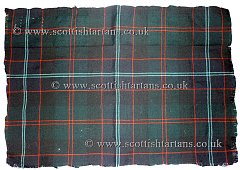|
-
An old piece in modern colours
Following a discussion on Weathered Colours in another thread I thought I'd post this picture as an example of just how confusing the whole dye terminology can be.

To many an eye these shades would conform to what we call Modern Colours i.e. those that are supposed to represent the darker chemical shades that came in with aniline dyes post 1855. However, this is a piece of Wilsons' Lochaber tartan and dates to c1800-20, a time before artificial dyes. This is a good example of the fact that natural, like any other dyestuffs, can be used to achieve a wide range of shades, it's just down to personal and customer preference.
-
The Following 7 Users say 'Aye' to figheadair For This Useful Post:
-
 Originally Posted by figheadair

Following a discussion on Weathered Colours in another thread I thought I'd post this picture as an example of just how confusing the whole dye terminology can be.

To many an eye these shades would conform to what we call Modern Colours i.e. those that are supposed to represent the darker chemical shades that came in with aniline dyes post 1855. However, this is a piece of Wilsons' Lochaber tartan and dates to c1800-20, a time before artificial dyes. This is a good example of the fact that natural, like any other dyestuffs, can be used to achieve a wide range of shades, it's just down to personal and customer preference.
Isn't the only difference here that Wilson's replaced their regular green shade with dark green? The purple, scarlet, and light blue look typical to me.
-
-
 Originally Posted by davidlpope

Isn't the only difference here that Wilson's replaced their regular green shade with dark green? The purple, scarlet, and light blue look typical to me.
Nearly, but the blue is a true dark navy and not their purple. This is possibly (probably?) their 'dark blue' as opposed to their standard 'blue'. What's interesting is that neither darker shade is specified in the 1819 count, just the standard blue and green, which these aren't.
The point of my OP was to highlight that such dark shades can be and were obtained from natural dyes contrary to what is often said of these dyestuffs.
-
-
Great thread, I too was following the other thread and find this technical stuff of great interest.. Keep it coming fellas!
"Everything is within walking distance if you've got the time"
-
-
 Originally Posted by figheadair

Nearly, but the blue is a true dark navy and not their purple. This is possibly (probably?) their 'dark blue' as opposed to their standard 'blue'. What's interesting is that neither darker shade is specified in the 1819 count, just the standard blue and green, which these aren't.
The point of my OP was to highlight that such dark shades can be and were obtained from natural dyes contrary to what is often said of these dyestuffs.
Thanks. I agree completely. The notion that only pale, weak colors can be obtained by natural dyes is, as we say in the South, hogwash.
-
-
 Originally Posted by davidlpope

Thanks. I agree completely. The notion that only pale, weak colors can be obtained by natural dyes is, as we say in the South, hogwash.
Exactly. Here's some of my own work with traditional natural dyes.

-
The Following 2 Users say 'Aye' to figheadair For This Useful Post:
-
i think the only reason natural dyes appear lighter in color is without the uv protection of modern dyes they sun bleach easier
-
 Posting Permissions
Posting Permissions
- You may not post new threads
- You may not post replies
- You may not post attachments
- You may not edit your posts
-
Forum Rules
|
|



















Bookmarks